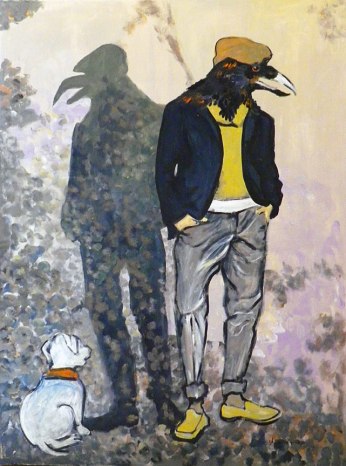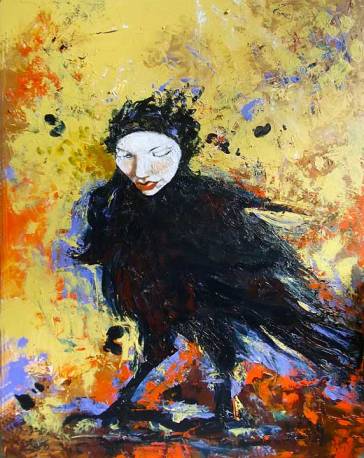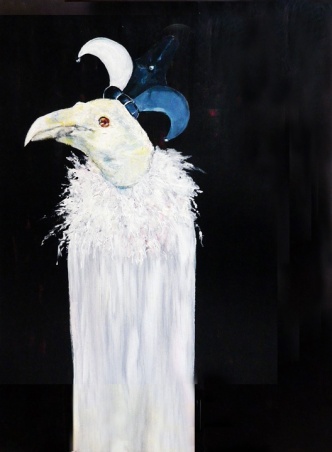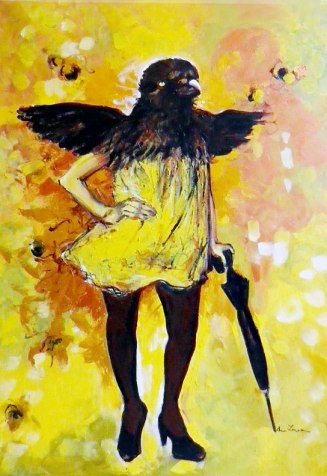For this interview, The Spectatorial asked Eva Lewarne, a prominent art force in Canada and overseas, to share some of her experiences, wisdom, and creative juice with the speculative audience interested in the fantastical and unique art.
I have had the privilege of working with Eva’s art before, and have seen her work live and up-close in galleries around Toronto. Her work is a fascinating blend of quirky, intellectual, and thought-provoking experiences that get one to think and feel, and I was thrilled that she agreed to an interview, which was conducted by email.
This interview has been edited for style and clarity.

You say that painting is your first and last love. How do you remember that first spark?
Even as a young child I observed people’s faces, their bone structures, and lights and shadows. I was visual….and at 8 years of age, while everyone in the family was watching their new black and white TV, I was sitting on the floor with my sketch pad drawing their feet.
Above my bed I had hung a print of the Mona Lisa and across from her a Modigliani copy.
As a teenager I drew the Beatles, whom I adored of course, and my teachers hung all my work on their walls. My first report card in elementary school read that I was a very good artist.
I was happiest painting and drawing, and later as a teenager writing poetry. Socializing was a secondary choice. I liked being alone and was never bored, still am not.
Your work is often surreal and fantastic, both in painting and photography, how do you come up with these ideas? Is it a long process or a spur of the moment thing?
I try to keep my mind still and not overly cluttered and keep my wants simple. My inner life experiences somehow manifest themselves in my art unintentionally.
I try not to have pre-conceived ideas and wait to see what ideas emerge in my mind and stick around. I particularly try to not think about what is fashionable or what will sell, even though it would be nice to make a living at it.

I am the opposite of a conceptualist. I would call myself an intuitivist.
I wait to hear what my intuition is trying to express itself on canvas. I like going to galleries and looking at other people’s work because occasionally an “Aha!” occurs and an idea materializes, not necessarily related to what I saw, but stimulated by it.
Also, I am an avid reader and sometimes am stimulated by poetry and other literature, but most often the painting happens first and then I read something that tells me what I painted.
An example was a series of bird women I painted in the 90s and exhibited in France. One day I had just finished a painting with a woman’s face and a jaguar artifact and went out to rest and have a coffee. I passed a bookstore on the way and went to a shelf of books randomly and a book fell out right at my feet called Jaguar Woman by Lynn Andrews. I couldn’t put it down because it introduced me to North American Aboriginal Philosophy, which I knew nothing about prior to doing that painting series.
Have any of the multitude of showings you have done, like the one at the Grand Palais in Paris, and the awards you have won, somehow altered how you create or perceive yourself in creating art?
It stopped me from feeling guilty about being an artist rather than doing good in the world. Raising two children and making a living as well often left me torn between my priorities, BUT that kind of acclaim left no doubt in my mind that I need to paint, that this is what I am meant to be doing. Especially when they stole all my paintings from a big International Show at the Grand Palais.
I was told that it means the patrons locked them in their vault waiting for me to die, because they had decided I will be a significant artist in the future. Of course, no such thing occurred in Canada back then as very few people even knew what the Grand Palais was or that Picasso was discovered there, that even not a lot of French artists are invited to exhibit there.

Having international acclaim gave me the courage to continue as an artist, despite the cost of materials (as I had no rich family to rely on).
I found very little appreciation for my art here, often being told by Canadian galleries that my art is “too European”. I think what they meant was “we are not interested in female spirituality, only conceptualism and what our clients will buy, i.e., abstract decorative art, with no emotions please and no figures”.
I think back then The Group of Seven dominated people’s appreciation of art and people wanted landscape or abstract only. I am mainly a figurative and/or figurative/abstract artist steeped in expressing and evoking emotions, which to me are the essence of being alive.
Also while in Paris for my next exhibition there at the Sorbonne, I discovered that the only Canadian artist people in France had heard about was Norval Morrisseau, while Canadians did not know about him.
Canadian art back then was not interested in what was happening internationally because the gallery owners here wanted to be the leaders of what their clients and collectors purchased. And Canadians were too sheepish to question them.
In New York, for example, people bought the art they loved even if they had no furniture, while here they hired their decorators to purchase their art. Luckily things are changing and have changed substantially in Canada, but alas REAL collectors still go to Europe and NY to purchase art, not supporting their own artists.
It is that old low self-esteem at play. If I could have moved to France back in the 90s I think I might have actually made a living at painting, but I had children here and a mother to look after.
What comes to your mind when you hear the term speculative art?
It makes me think of gambling or prophetic, futuristic art, but really all true art should be futuristic. Otherwise why reiterate what is all already known by everyone? That is what makes art transcend time, like Shakespeare.
It has to come from an authentic experience of an artist’s inner life; that is what makes art alive, when magic happens.
There is a fantastic, magical element in all of your work. How much of that would you say has been born out of the stories and fairytales you grew up with and have been surrounded by? Not just as a child, but overall?
Growing up in Poland, although supposedly a Catholic country, I was fed stories of faeries, dwarfs, nature spirits, and magic in the children’s literature that I was raised on. Paganism was alive and well, with a love of feminine spirituality. I think some countries appreciate the feminine more than others and call themselves Mother rather than Father lands, Poland and France among them.

Let’s talk about your photography, because that’s a force in it’s own right. When did your photographic endeavor begin?
I have always loved photography, because of the detached way one can observe life around them without being self-conscious.
I could never afford a decent camera until the government, after I was laid off from my part-time job at the age of 63, paid my tuition to do a Digital Certificate course at GBC, thinking I stood a better chance at making money with it than painting, and so gave me money to buy a canon T3i. I was in love instantly. Also, I had learned Photoshop on my own when looking for work I was asked to teach it….it is a perfect companion for digital photography.
How much of a different process from painting is it for you?
Actually, it is no different as I can express the same sentiments and feelings with it.One inspires the other, although I have been reluctant to do mixed media, one because of the cost of printing and two because it seems like cheating to paint on a photo, and I like the ambiance of photos on their own.
Playing in Photoshop is very much a process of intuitive explorations for me, very much like painting. People who say there is something “not right” about using Photoshop are people who I would say haven’t bothered to learn the tool. If they have the money and resources to build their own live sets, good for them. I don’t, and can build any set I need in Photoshop. Digital photography NEEDS Photoshop.
Would you have any words of wisdom to those who would like to pursue art of this caliber, work that is steeped in folklore, spiritualism and magic?
I think real art is only of that caliber. The rest of what people call art is really dead decoration or advertising, a game for the wealthy and the bored.
Art has to be authentic.
Pursing something that you find intellectually stimulating won’t work, you have to create from your own intuition.
However there are ways that your intuition can become clearer to you. Meditation, silence, for one, may give you an “Aha!” moment about what it is that you are meant to be expressing with your art.
I don’t want to give a format or path because that would be defeating the purpose of this kind of art.
– contributed by Magdalena Wolak
Eva Lewarne’s main art page: http://www.evalewarne.com
Eva’s photography page: http://www.evalew.com
